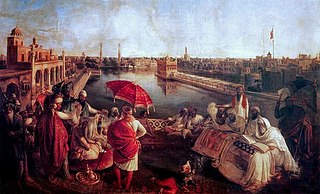This is a list of Gurdwaras in Latin America. A gurdwara is a Sikh temple.
This is a list of Gurdwaras in Latin America. A gurdwara is a Sikh temple.

Sikhs are people associated with Sikhism, a monotheistic religion that originated in the 15th century, in the Punjab region in the northern part of the Indian subcontinent, based on the revelation of Guru Nanak. The term Sikh has its origin in the words शिष्य, meaning a disciple or a student. A Sikh, according to Article I of the Sikh Rehat Maryada, is "any human being who faithfully believes in One Immortal Being; ten Gurus, from Guru Nanak to Guru Gobind Singh; Guru Granth Sahib; the teachings of the ten Gurus and the baptism bequeathed by the tenth Guru". Sikhs are considered as a separate ethnic group in the United States.

Nankana Sahib is a city and capital of Nankana Sahib District in the Punjab province of Pakistan. It is named after the first Guru of the Sikhs, Guru Nanak, who was born in the city and first began preaching here. Nankana Sahib is the most important religious site for the Sikh religion. It is located about 91 km (57 mi) west of Lahore and about 75 km (47 mi) east of Faisalabad. According to the census of 2017 the city has a population of 79,540 inhabitants. Until 2005, it was the part of Sheikhupura District.
A gurdwara is a place of assembly and worship for Sikhs. Sikhs also refer to gurdwaras as Gurdwara Sahib. People from all faiths, and those who do not profess any faith, are welcomed in Sikh gurdwaras. Each gurdwara has a Darbar Sahib where the current and everlasting guru of the Sikhs, the scripture Guru Granth Sahib, is placed on a takhat in a prominent central position. The raagis recite, sing, and explain the verses from the Guru Granth Sahib, in the presence of the congregation.

The following outline is provided as an overview of and topical guide to Sikhism:
The Khalistan Zindabad Force (KZF) is a militant group, and is part of the Khalistan movement to create a Sikh homeland called Khalistan via armed struggle. Government of India and the European Union have declared and banned KZF as a terrorist organisation.
Sikhism is a minority religion in Belgium, but Sikhs have played a role in Belgian history; during World War I, many Sikhs fought in Belgium. In the First Battle of Ypres, an entire platoon of Dogra Sikhs died.
German Sikhs are a religious minority in Germany. Many German Sikhs have their roots from the Punjab region in India. They number between 15,000 to 21,000. Germany had the third highest Sikh population in Europe after United Kingdom and Italy.

Sikhism in Scotland includes all aspects of Sikh life and Sikhism in Scotland. Sikhs have been present in Scotland for over a century, with the first documented Sikh, Maharaja Daleep Singh, arriving in Perthshire in 1855. The next wave of migration was in early-to-mid 1920s when prominent Sikhs of the Bhat/Bhatra community established themselves in Glasgow and Edinburgh. However, the bulk of Sikhs in Scotland come from families who immigrated during the late 20th century. In Scotland Sikhs represent 0.2% of the population (9,055).

Gurdwara Darbar Sahib Kartarpur, also called Kartarpur Sahib, is a gurdwara in Kartarpur, located in Shakargarh, Narowal District, in the Punjab province of Pakistan. It is built on the historic site where the founder of Sikhism, Guru Nanak, settled and assembled the Sikh community after his missionary travels and lived for 18 years until his death in 1539. It is one of the holiest sites in Sikhism, alongside the Golden Temple in Amritsar and Gurdwara Janam Asthan in Nankana Sahib.

Gurdwara Janam Asthan, also referred to as Gurdwara Nankana Sahib, is a highly revered gurdwara that was built at the site where the founder of Sikhism, Guru Nanak, was believed to be born. The shrine is located in the city of Nankana Sahib, near the city of Lahore in the Punjab province of Pakistan.
Sikhism in the United Arab Emirates has a following of over 50,000; the majority of Sikhs in the UAE are found in Dubai and are expatriates hailing from Punjab, India. There are smaller numbers of Pakistani Sikhs also.
Neapalese Sikhs first entered Nepal in the 18th century. Today, there is a small community of Sikhs living in Nepal, totaling around 7,000 people according to the 2011 census.

Sikhism in Greater Vancouver, is one of the main religions across the region, especially among the Indo-Canadian population. The Sikh community in Vancouver is the oldest, largest and most influential across Canada, having began in the late 19th century. By 1995, Vancouver had one of the two largest Sikh populations in the world that are not in India. In 2003, the Sikhs became the largest group in Greater Vancouver who did not practice Christianity.
Sikhism in Panama took roots when Panama Canal was started in 1890 by an American company.Panama got separated from Spain in 1821 and joined with Columbia, with which it remained till 1903.Construction of rail-road link between Atlantic and Pacific Oceans was started in 1850. With the boom of labour opportunities, large no. of immigrants saw Panama as a place for fortune. Sikhs came first as construction workers for trans continental rail road link. During 1864, among the population of New Granda, for which Panama City was part there of then, out of 27.47 lac, 1.65 lacs were Indians including large no. of Punjabi and Sikh population. Many sikhs left Isthmus after completion of rail link but a large no. remained and got settled there..